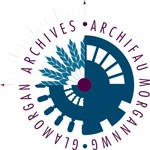The Cardiff Royal Infirmary on Newport Road is a significant landmark on the local skyline, well known by residents and many visitors to the city. What is not so well known is that the Infirmary, opened on its present site in September 1883, is the second hospital to have been built on Newport Road.
This is the first in a series of articles on the building and opening of what was, in 1883, a ‘state of the art’ hospital. It draws on records, plans and photographs held at Glamorgan Archives to trace the early days of a hospital built to provide care for the thousands attracted to South Wales in the latter half of the 19th century by opportunities in the iron, coal and shipping industries.

Drawing of the proposed Infirmary, 1837 (DV74/8)

Plan of the proposed Infirmary, 1837 (DV74/7)
The first hospital, known as the Glamorganshire and Monmouthshire Infirmary and Dispensary, had opened in January 1837 on a site on Newport Road now occupied by the Cardiff University School of Engineering. It was built to provide “care for the deserving poor” at a time before public funding for hospitals. The hospital could call on the services of a physician and 2 surgeons. Salaried staff, however, were limited to a House Surgeon, Matron, one nurse, a porter and a housemaid. Along with facilities for outpatient care the new infirmary had 20 beds for those admitted for treatment. Nevertheless, although modest in size, the construction and maintenance of such a facility was an immense challenge as the hospital was completely reliant on annual donations and subscriptions.

Annual Report of the Glamorganshire and Monmouthshire Infirmary and Dispensary for the year ending December 1837 (DHC48)
Much was owed to one man, Daniel Jones, a solicitor, of Beaupre Castle. Jones provided £3,425, a phenomenal sum at the time, to fund the construction of the first infirmary. The portico above the main door acknowledged his contribution with the inscription ‘Infirmary erected at the sole expense of Daniel Jones of Beaupre’. While much of the money needed for both the maintenance and running of the hospital came from a number of well-known figures, including the Marquess of Bute, the people of South Wales also gave generously year after year for ‘their hospital’.
From the outset the new hospital was far from perfect. In 1843, only 6 years after its construction, the management committee complained that the building suffered from:
…damp walls, smoky chimneys, dry rot in the skirting boards, imperfect pipes … and inadequate drainage.
In 1873, although connections to the local sewers had been improved, an outbreak of erysipelas led to a temporary closure for cleaning, with patients housed in a tent at the rear of the building. Despite an increase in the numbers of beds to 60, by 1876 it was agreed that a new, larger and modern hospital was needed that could cater for a population that had increased in the Cardiff district alone from 8,000 in 1831 to 71,000 in 1871.
The campaign for the new hospital was launched by the Bishop of Llandaff, Alfred Oliphant, with the words Let us all do what we can towards this great and benevolent object. It was estimated that £26,000 would be needed for the building work alone. Given the reliance on donations and public subscription this was no easy task. By now the infirmary had over 500 annual subscribers, sometimes companies and well known families, but often people from across the two counties, many of whom could only afford a £1 a year and sometimes less. In addition, donations were received from collection boxes in local pubs, clubs and theatres, including the Rummer Tavern, the Maendu Working Men’s club and the Theatre Royal. Money also came from the proceeds from exhibitions and concerts plus gifts from grateful patients. However, perhaps the most striking aspect was that since 1873, once a year, on ‘Infirmary Sunday’, churches made a special collection for the hospital. In addition, businesses small and large made an annual work place collection on ‘Infirmary Saturday’.
Nevertheless, the records of the Building Sub Committee charged with raising the finance illustrate just what a herculean task it was to raise enough money to meet both annual running costs and build a new hospital. So much so that plans for a chapel in the initial proposals were soon dropped and the number of beds scaled back to 100, with the possibility of expansion at a later stage to 200. Yet the committee still concluded, on 16 July 1878, two years after the campaign had begun, that there was:
…no prospect of success at present… and that …the project was becoming daily more unpopular with the townspeople.
Much was blamed on a trade depression that had reduced wages and donations. It appeared that all was lost and the committee was mothballed for two years until Christmas Eve 1880. The story of how the project was revived is told through the next article in this series.
Glamorgan Archives holds the records of the Glamorganshire and Monmouthshire Infirmary and Dispensary. For plans of the hospital opened in 1837 see DV/74/1-9. For the annual reports produced by the hospital management committee from 1837 onwards see DHC/48-50. For records of the New Infirmary Building Sub Committee see DHC/44.
Tony Peters, Glamorgan Archives Volunteer





